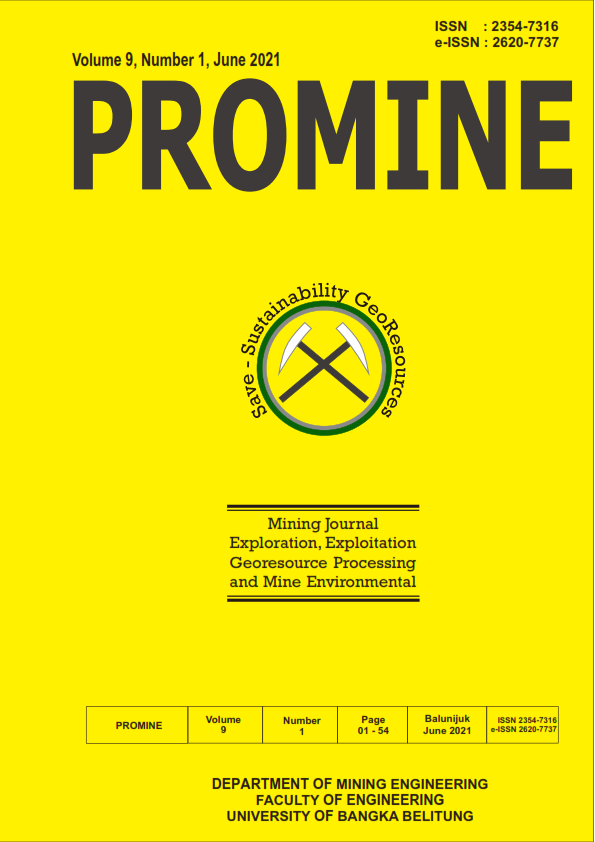Investigasi kondisi airtanah dengan geolistrik: studi kasus endapan aluvial di Bengalon Kutai Timur, Provinsi Kalimantan Timur Indonesia
An investigation of groundwater condition by geoelectrical resistivity method: A case study in Bengalon, East Kutai, East Kalimantan Province Indonesia
DOI:
https://doi.org/10.33019/promine.v9i1.2306Keywords:
groundwater, geoelectric, alluvial, bengalonAbstract
Bengalon is located in East Kutai Regency, East Kalimantan Province. Bengalon is included in the Samarinda-Bontang groundwater basin. The development of agricultural and industrial areas, followed by an increase in residential areas, will cause an increase in the water demand. This study aims to determine the groundwater potential of alluvial areas using the resistivity geoelectric method. The resistivity survey resulted in subsurface lithology, shallow groundwater conditions in the form of depth, thickness, and location of the aquifer as well as the type of groundwater quality. There are 10 locations for geoelectric data collection using the 2D geoelectric method. The results showed that the majority of the aquifers were alluvial deposits consisting of sand and sandy clay. The resistance indicating groundwater is 1 - 4 Ω m, at a depth of 10 – 50 m with a thickness varying from 10 – 20 m which has been dominated by sand. The presence of sea water intrusion in aquifers causes the quality of groundwater to tend to be brackish because the research location is in a swamp area bordering the coast.
References
Azhar, and Handayani, G., 2004. Application of Schumberger configuration geoelectric method for determination of coal type resistance. Jurnal Natur Indonesia 6 (2), 122-126.
Devy, S. D., and Sarungallo, C., 2018. Groundwater aquifer study on coal mining area: a case of North Samarinda, Indonesia. Journal of Degraded and Mining Lands Management 6(1), 1483-1493.
Fetter, C. W., 2001. Applied Hydrogeology 4th edition. Prantice-Hall, Inc. New Jersey, 621p.
Grant, F. S., and West, G. F., 1965, Interpretation theory in applied geophysics. McGraw-Hill Book.
Koefoed, O., 1979. Resistivity sounding on an earth model containing transition layers with linear change of resistivity with depth. Geophysical Prospecting 27(4), 862-868.
Lowrie, W., 2007. Fundamentals of geophysics. Cambridge University Press.
Mohammad, F., Mardiana, U., Yuniardi, Y., Firmansyah, Y. and Alfadli, M. K., 2016. Ground water potential based on rock resistivity value in Cangkorah Village, Kecamata Batujajar, West Bandung Regency. Bulletin of Scientific Contribution 14(2), 141-152.
Santoso, B., 2016. Penerapan Metode Geolistrik 2D untuk Identifikasi Amblasan Tanah dan Longsoran di Jalan Tol Semarang – Solo KM 5+400 – KM 5+800. Jurnal Spektra 1(2): 179-186.
Sukardi, N. Sikumbang, I. Umar, dan R. Sunaryo, 1995. Peta Geologi Bersistem Indonesia, Lembar Sangatta, Nomor 1916 Skala 1:250.000, 1995. Pusat Penelitian dan Pengembangan Geologi, Bandung.
Telford, W. M., Gerald, L. P., and Sheriff, R. E., 1990. Applied Geophysics. Second Edition. Cambridge University Press.
Timotius, Putra, Y. S., Lapanporo B. P., 2014. Identifikasi Keretakan Beton Menggunakan Metode Geolistrik Resistivitas. Jurnal Prisma Fisika 2(2), 92-99.
Todd, D. K., and Mays, L. W., 2005. Groundwater hydrology edition. Welly Inte, 891pp.
Wilopo, W., Putra, D. P. E., and Susatio. R., 2020, Aquifer distribution and groundwater geochemistry in Bojonegoro Sub-district, Bojonegoro District, East Java Province, Indonesia. Journal of Degraded and Mining Lands Management 7(4), 2327-2335.



